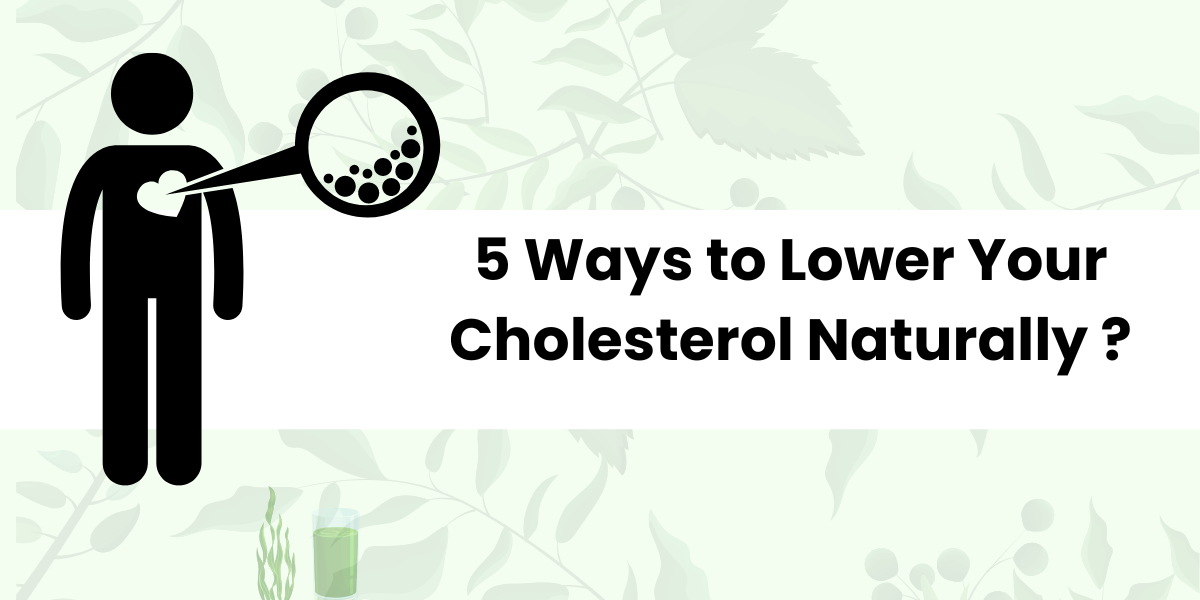5 Ways to Lower Your Cholesterol Naturally

Let’s start by defining cholesterol. Our bodies require cholesterol, a waxy, fatty molecule, in order to develop healthy cells. Although it frequently has a bad rap (and too much can be harmful), cholesterol is actually essential for the health of our bodies.
Different types of cholesterol exist. Low-density lipoprotein (LDL), also known as “bad cholesterol,” can form plaque in your arteries, increasing your risk of atherosclerosis, heart disease, vascular problems, and other conditions. High-density lipoprotein (HDL), or “good cholesterol,” on the other hand, really aids in the removal of that bad cholesterol from your system.
High LDL and low HDL values are typically associated with high cholesterol levels. One in three Indians suffers from high cholesterol levels. However, there are things you can do to improve your HDL and reduce your LDL.
Here are five things you can do to lower your cholesterol naturally.
Read the nutrition labels to avoid trans fats
Reading nutrition labels is one of the simplest things you can do to help control your diet, so you’ve definitely heard this advice repeated time and time again.
You can use nutrition labels to identify the healthy elements you consume and to steer clear of trans fats, which are among the worst ingredients for your cholesterol levels.
Trans fats, commonly referred to as “hydrogenated oils” or “partially hydrogenated vegetable oil,” are ingenious ingredients that may benefit food producers but are bad for you.
Trans fats make things more enduring, which makes them simpler to ship and store. They can be found in a lot of processed foods and many baked items made with margarine or shortening. Unfortunately, they also increase levels of dangerous LDL cholesterol while lowering levels of good HDL cholesterol.
Therefore, if you genuinely want to lower your cholesterol, read labels and make an effort to avoid trans fats whenever you can. Cutting them out of your diet can have a significant impact because they are among the worst culprits when it comes to high cholesterol.
Choose leaner meats like fish or chicken that are lower in saturated fats
Is your refrigerator looking a little emptier than usual? Review your shopping list to see if there are any simple protein substitutions you can make before you go to the store to refill.
Start by limiting your intake of red meat. Saturated fats, which are abundant in many types of red meats and can increase levels of harmful LDL cholesterol. Avoid processed meats and go for skinless chicken or skinless turkey more frequently for healthier choices. Additionally, you might try including more fish in your diet.
Fish is low in saturated fats and contains a variety of omega-3 fatty acids that are beneficial for your heart and can raise your levels of good HDL cholesterol.
Increase soluble fibre intake with whole grain bread, kidney beans, quinoa and more
You undoubtedly already know that fibre can improve your intestinal health. However, if you believed that fibre was only useful for digestion, reconsider; it can also improve your cardiovascular health.
Soluble fibre is abundant on a list of foods low in cholesterol (the fibre that can dissolve into water). To lower levels of harmful LDL cholesterol, soluble fibre absorbs cholesterol in the gut before it enters the bloodstream.
However, it’s crucial to keep in mind that not all “healthy” foods are made equal. In general, the more processed a grain or bean is, the less likely it is to be nutritious and provide health advantages. Whenever possible, try to stock up on fresh ingredients.
Snack on fruits, veggies, and nuts to increase unsaturated fats and fibre
Having a snack between meals to increase energy or calm an upset stomach is perfectly acceptable. However, frequent snacks like crackers, cookies, pastries, microwave popcorn, chips, and other baked goods are high in trans and saturated fats.
On the other hand, snacking on fruits, veggies, and nuts helps you receive both good fats and fibre in addition to helping you avoid toxic fats.
Unsaturated fats, the healthiest sort of fats, are abundant in raw nuts. Because they increase your levels of good HDL cholesterol and decrease your levels of bad LDL cholesterol, nuts are excellent for a heart-healthy diet.
Avocados and olives are further examples of foods high in unsaturated fat. In addition to numerous fruits and vegetables, nuts can be a fantastic source of soluble fibre.
Consider taking milk, cheese, and yoghurt with low fat
Making wiser decisions is all it takes to lower your cholesterol; you don’t have to give up everything you love. Dairy is a common food where choosing a healthy substitute can be simple and successful.
Use low-fat dairy products instead of standard ones for foods like cheese, milk, cream, and yoghurt. Don’t be afraid to experiment; give soy milk a shot. The future? It can turn into your upcoming craving.
Because full-fat dairy products contain saturated fat as well as cholesterol, making these changes is beneficial. By choosing a low-fat (or non-fat) option, you’re boosting your blood’s cholesterol levels.
Final Thoughts
You can achieve improved cardiovascular health that lasts by altering your diet, increasing your exercise, stopping smoking, dropping weight (if necessary), and connecting regularly with your doctor.
Does that seem like a lot of work? Don’t allow yourself to be intimidated. It’s not necessary to drastically alter your lifestyle in order to lower your high cholesterol. Instead, begin by altering your perspective. You should conceive of it as going toward new behaviours that will enable you to build a healthier and more joyful future rather than moving away from things.
The best time to begin caring for your heart health is always right now. Ask your friends and family for help if you need it. Also keep in mind that your doctor is always available to you with guidance, inspiration, and support to help you achieve your objectives and live a better life.




